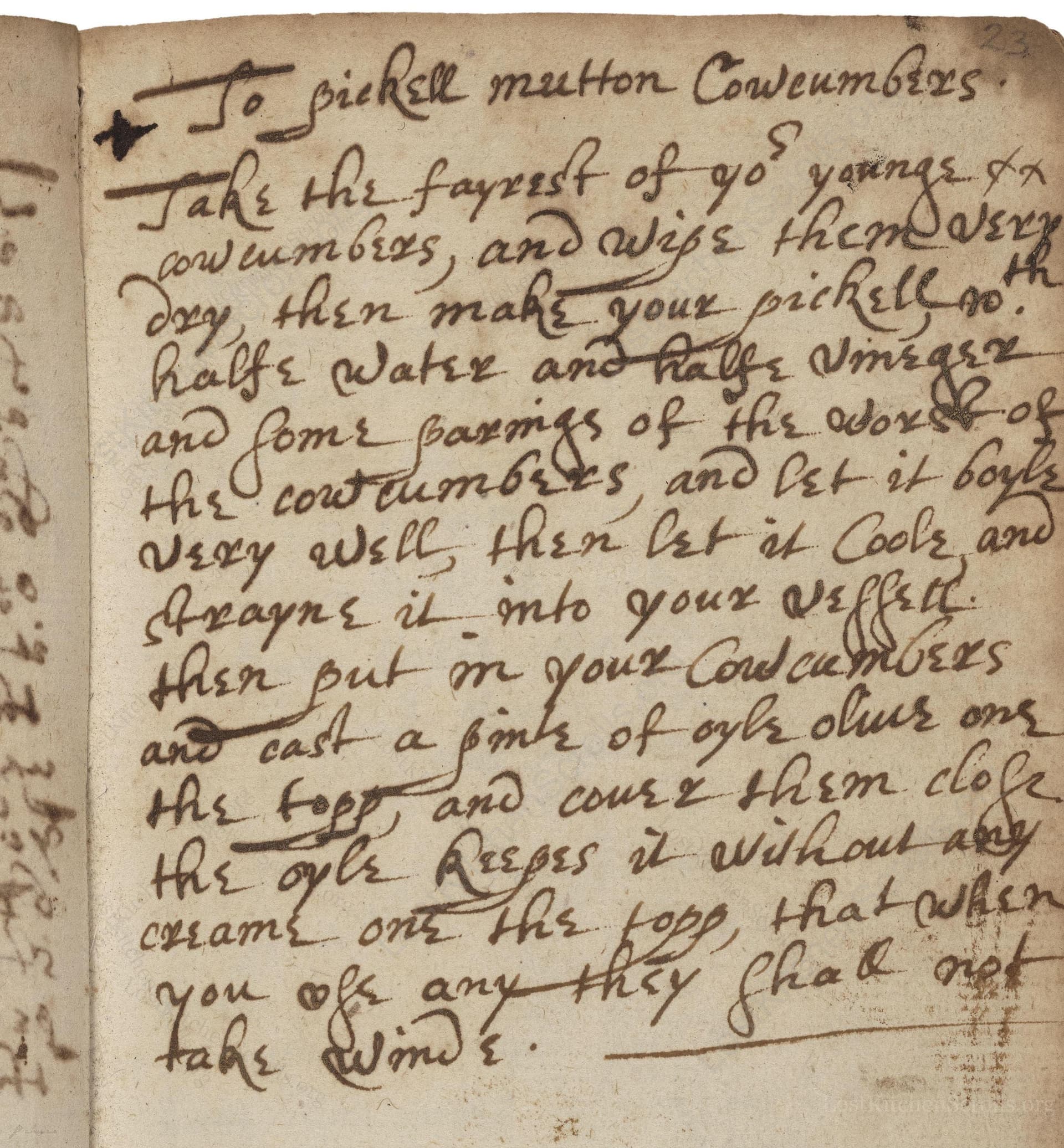To Pickell Mution Cowcumbers
From the treasured pages of Medicinal and cookery recipes of Mary Baumfylde
Written by Mary Baumfylde

To Pickell Mution Cowcumbers
"Take the fayrest of yo ngs, & wippe them very dry, then make your pickell so: halfe Water and halfe Vineger and some parings of the worts of the Cowcumbers, and let it boyle Very Well, then let it Coole and Strayne it into your vessell. Then put in your Cowcumbers and cast a pinte of oyle oluer one the topp, and couer them close. the oyle Keeps it without any creame on the topp, that when you vse any they shall not take Wind &."
Note on the Original Text
The original recipe is written in early 17th-century English, characterized by phonetic spelling and a flowing, conversational tone. 'Pickell mution Cowcumbers' simply means 'pickled mountain cucumbers', with 'mution' likely being an age-old term or misreading. Words like 'boyle', 'couer', and 'vse' reflect older spelling conventions, and much of the direction assumes prior kitchen experience, omitting exact measurements and timings. This style relies on implied knowledge and resources available in a well-stocked household, highlighting the oral and adaptive nature of historical cookery.

Title
Medicinal and cookery recipes of Mary Baumfylde (1626)
You can also click the book image above to peruse the original tome
Writer
Mary Baumfylde
Era
1626
Publisher
Unknown
Background
A sumptuous journey into early 17th-century English cookery, this delightful volume offers a tantalizing glimpse into the recipes, flavors, and culinary secrets that once graced aristocratic tables. Prepare for a taste of history, presented with wit and wisdom!
Kindly made available by
Folger Shakespeare Library
This recipe hails from early 17th-century England, specifically attributed to Mary Baumfylde, an active housewife and compiler of household receipts around 1626. It provides a glimpse into early modern food preservation practices before the advent of canning. Pickling was a crucial technique in a world without refrigeration, and oil was often employed as an airtight seal to protect preserves from spoiling. Baumfylde's careful attention to detail, such as using only the fairest young cucumbers and incorporating their own peelings into the brine, reflects both resourcefulness and an appreciation for flavor. Recipes like this were often passed down in household receipt books, commonly maintained by women managing the kitchen and domestic affairs.

In its day, this recipe would have been prepared using everyday kitchen tools: a lidded earthenware or stoneware jar, a large cauldron or pot for boiling the brine, and a strainer (often muslin or a coarse sieve) to remove the peelings. Preservation vessels were typically large, sturdy, and sealable to keep out vermin and dust. Picking and wiping cucumbers clean would have been done by hand, and plenty of labor went into ensuring a clean, well-maintained household for successful pickling.
Prep Time
15 mins
Cook Time
10 mins
Servings
10
We've done our best to adapt this historical recipe for modern kitchens, but some details may still need refinement. We warmly welcome feedback from fellow cooks and culinary historians — your insights support the entire community!
Ingredients
- 1 lb young, small cucumbers
- 2 cups water
- 2 cups white wine vinegar (substitute with apple cider vinegar if preferred)
- Peelings from cucumbers (or if unavailable, a few extra slices of cucumber for flavor)
- 2 cups olive oil (or sufficient to cover the pickles)
Instructions
- Begin by selecting the freshest, youngest cucumbers you can find—these are preferred for their crispness and tender skin.
- Gently wipe them dry to remove any moisture or dirt.
- For the brine, combine equal parts water and white wine vinegar in a saucepan, using about 2 cups of each for every 1 pound of cucumbers.
- Add a handful of cucumber peelings, ideally from the cucumbers you are pickling, to infuse extra flaver.
- Bring this mixture to a vigorous boil and allow it to cook for several minutes.
- Once boiled, set aside to cool completely.
- Strain out the peelings and transfer the liquid into a sterilized glass jar or ceramic crock.
- Add the cucumbers to the veshel.
- Finally, pour approximately 2 cups of olive oil over the top to completely cover the surface.
- Seal tightly; the oil layer will prevent any mold or 'cream' from forming and keep the pickles fresh.
- When you wish to consume, remove cucumbers as needed, ensuring the others remain submerged and protected.
Estimated Calories
120 per serving
Cooking Estimates
This recipe takes about 10 minutes to cook the brine and 15 minutes to prepare the cucumbers and materials. Each serving has about 120 calories, if you consider 10 servings from a batch. Most vinegar pickles like these need just a short cooking time; most time is spent cooling and preparing.
As noted above, we have made our best effort to translate and adapt this historical recipe for modern kitchens, taking into account ingredients nowadays, cooking techniques, measurements, and so on. However, historical recipes often contain assumptions that require interpretation.
We'd love for anyone to help improve these adaptations. Community contributions are highly welcome. If you have suggestions, corrections, or cooking tips based on your experience with this recipe, please share them below.
Join the Discussion
Rate This Recipe
Dietary Preference
Main Ingredients
Culinary Technique

Den Bockfisch In Einer Fleisch Suppen Zu Kochen
This recipe hails from a German manuscript cookbook compiled in 1696, a time whe...

Die Grieß Nudlen Zumachen
This recipe comes from a rather mysterious manuscript cookbook, penned anonymous...

Ein Boudain
This recipe comes from an anonymous German-language manuscript cookbook from 169...

Ein Gesaltzen Citroni
This recipe, dating from 1696, comes from an extensive anonymous German cookbook...
Browse our complete collection of time-honored recipes



